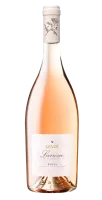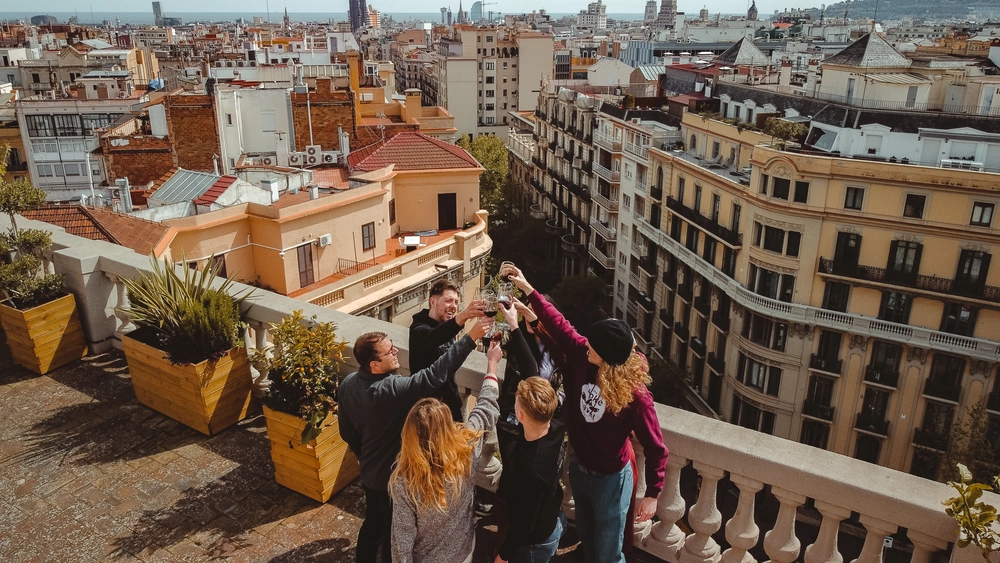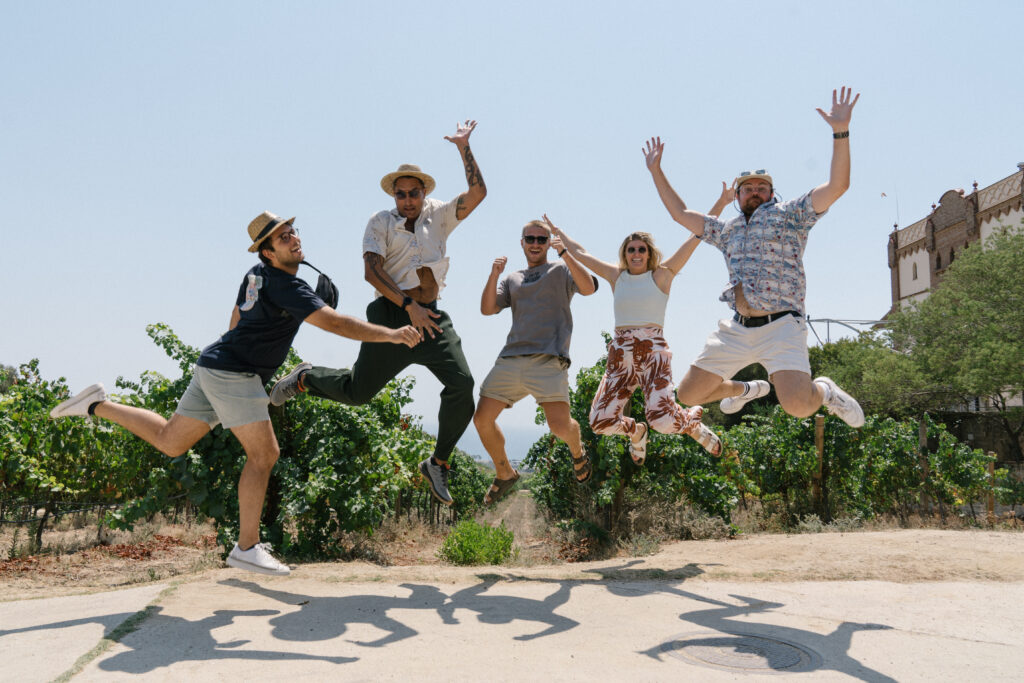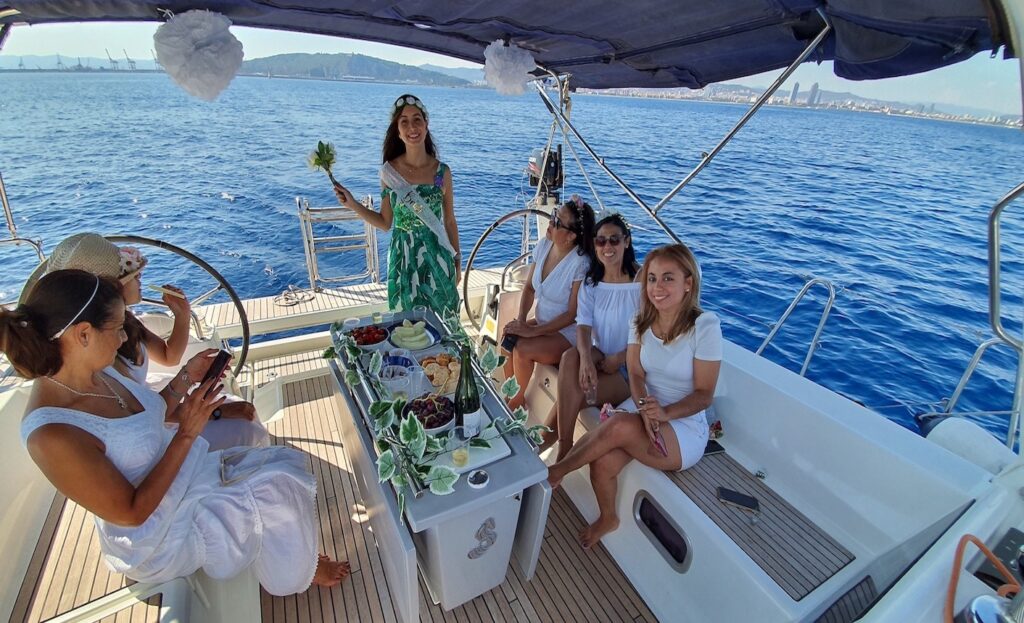It was really hard narrowing our Barcelona wine tastings down to just six wines. When we did the tasting with our wine supplier to choose the wines, he brought maybe 25 bottles for us to sample. And as the kind of people who get excited over opening a bottle of vinegar, we loved them all. But we love generous pours even more, and giving our wine tasters ample opportunity to assess each wine—and feel their effects, without blacking out before the reds—and so we had to settle on six. Six wines that weren’t only interesting and delicious to taste but also told a Spanish wine story.
Because Spanish wines are often misrepresented. Too many years of tourists falling into the traps laid for them, ending up swilling swill; of teenage sun-and-party vacations soaked in whatever’s cheap, nasty, and soon to be thrown up. Spanish wines get a bad rap because most of us don’t know what we’re doing with them. But we do. And we’re going to share that with you. Because for us, the wonders of Spanish wines are only superseded by the glory, ease, and ubiquity of Spanish wine-drinking culture. Once you know what you like and why you like it, you’re going to find it everywhere, always, and for next to nothing.
So join us on this journey through the six wines—or similar—that you simply must taste when you’re in Barcelona. Either with, or without, us.
Portium Cava: Why Spain’s Sparkler Beats Prosecco (And Matches Champagne)
Cava is Catalonia’s best-kept secret—or it was, until now. Unlike the sugary fizz of Prosecco, Cava is made the traditional way, which means bubbles are created right in the bottle, just like Champagne. But, because it’s Spanish, it comes without the ego (and price tag) of its French counterpart.
At our tastings, we start things off with Portium Cava, a locally produced sparkling wine from the heart of Penedès, Barcelona’s own backyard. Our guests regularly find themselves surprised by how much more sophisticated and balanced it is compared to the Prosecco they’re used to drinking back home. It’s crisp, clean, and dances on your tongue—bright with notes of green apple, citrus, and just enough creamy toastiness from its ageing to keep things interesting.
Prosecco gets its bubbles quickly, cheaply, and in bulk. Cava takes patience, love, and traditional methods—and you can taste the difference. And the best bit? Because you’re in Barcelona, it’s everywhere. Quality Cava is what the locals drink at their celebrations, Sunday lunches, and Friday night pre-parties—and now you can too.

“I usually go for Prosecco, but this Cava was next level—so fresh and crisp! It felt like a celebration in a glass.”
— Lena, 27, Berlin
“Never thought I’d be into sparkling wine, but Portium changed that. Smooth, fruity, and just the right amount of bubbles.”
— Jake, 24, Melbourne
“Bright, crisp, and somehow salty in the best way — like drinking a sea breeze. Perfect after a long, hot day wandering around Barcelona.”
— Erin, 32, Chicago

“I’m usually a red wine person, but K-Naia’s crisp and refreshing taste won me over. It paired wonderfully with our seafood dinner.”
— Liam, 35, Dublin
“The subtle herbaceous notes combined with the vibrant fruitiness made this wine stand out. It was like a taste of Spanish sunshine in a glass.”
— Isabella, 42, New York
Spain Has White Wine Too—Meet Our Two Most Popular Grapes
Spanish white wine has spent far too long stuck in the shadows of Rioja reds and summertime Sangria pitchers. But it’s high time we gave them their due. And at our tastings, we do exactly that—by introducing two crowd-pleasers: Albariño and Verdejo.
Albariño—Asorei Albariño from Galicia’s Ocean Breeze
If there’s one Spanish white wine that even casual wine lovers might recognise, it’s Albariño. Originating from Galicia, the misty northwestern corner of Spain, Albariño grows in vineyards that literally overlook the Atlantic. These grapes absorb ocean breezes and salty air, giving wines like our Asorei Albariño a distinct freshness and minerality.
When you swirl a glass of Asorei Albariño, you’ll smell citrus blossoms and sea spray. One sip, and you’ll notice crisp green apples, juicy lemons, and just a hint of peach. It’s clean, refreshing, and vibrant—the kind of wine you can (and probably will) drink all afternoon.
At our tastings, guests are usually surprised—not because Albariño is good (they expect that), but because they didn’t realise Spain could produce such a standout white. And honestly? Watching those “ah-ha” moments unfold never gets old.
Verdejo—K-Naia from the Heart of Rueda
Verdejo is the other Spanish white grape that you need to know. If Albariño captures the crisp coolness of Galicia’s coast, then Verdejo is the aromatic powerhouse of central Spain’s Rueda region. Here, endless sun and sharp temperature changes between night and day create wines with real character.
Our K-Naia Verdejo hits the glass singing with aromas of freshly-cut herbs, pineapple, and passionfruit. It’s tropical and bright, but with a surprising depth—there’s a complexity here you wouldn’t usually associate with Spanish whites (or at least, not yet).
In tastings, K-Naia never fails to convert guests into Verdejo lovers. It’s the bottle they’re always photographing, googling, and asking where they can find. And that’s the beauty of discovering great Spanish wines—they’re not just tasty; they’re actually accessible, affordable, and begging to be shared.
Rosé Myths Busted: Why Colour Doesn’t Define Dryness or Sweetness
Anais Rosat or Izare Rosado: Challenging Rosé Stereotypes
Rosé has a branding problem. Somewhere along the way, people got it into their heads that pale pink equals dry and sophisticated, and anything darker must be a sugary hangover in a bottle. But that’s bollocks. The truth is, colour in rosé comes down to how long the juice sits on the grape skins—nothing to do with sweetness. At our tastings, we pour Anais Rosat or Izare Rosado depending on what’s in season, and both make the same point: Spanish rosés can be fruit-forward and refreshing without being cloying or flat. These wines are dry, structured, and summery as hell. They’ve converted more than a few skeptics—and maybe that’s you next.

“Izare Rosado’s balance of acidity and smooth finish made it incredibly easy to drink. It complemented our seafood lunch perfectly.”
— Isabella, 29, Rome
“I was impressed by the depth of flavor in this rosé. It had a complexity that kept me coming back for more.”
— Tom, 38, Toronto

“This was so easy to drink I forgot it was red wine. Super juicy, super smooth, and somehow still refreshing? New favourite for sure.”
— Jess, 28, Manchester
“Not what I expected from a Spanish red—in the best way. Light, fruity, and went down way too fast. I could drink this all summer.”
— Mateo, 33, Buenos Aires

“This tasted like something you’d get in a fancy restaurant… except we were on a rooftop in Barcelona. Smooth, spicy, and just classy.”
— Anna, 31, San Francisco
“Finally learned what ‘Crianza’ means and now I want to try them all. This one was bold but not too much—like, grown-up wine I could actually enjoy.”
— David, 55, Toronto
Particular Garnacha: Light, Juicy, and Nothing Like You Expected
Spanish reds have a bit of a reputation—big, bold, full of oak and attitude. And yeah, those wines exist (and we’re not mad about it). But Spanish reds are also way more versatile than they get credit for. Take Garnacha: light on its feet, fruit-forward, and dangerously drinkable. It’s the red that works in a Barcelona summer. It’s the red that makes people double-check their glass like, “Wait… this is red?” Particular Garnacha is all juicy cherry, soft spice, and zero pretension—proof that red wine doesn’t have to weigh you down.
Biga Crianza: How Spain’s Ageing System Tells You What You’re Drinking
Then we shift gears. Biga Crianza , made from Spain’s flagship Tempranillo grapes, shows off what Spain’s ageing system is really about. Crianza means it’s had time in oak and bottle, so the fruit is still there, but it’s dressed up—smooth, structured, and way more serious. It’s the kind of red you want to sit with. And once you learn the ageing terms (Joven, Crianza, Reserva, Gran Reserva), you’ll realise Spanish labels are actually doing you a favour—giving you a roadmap to flavour and style. These two wines tell the full story: Spanish reds can be easy or intense, fresh or firm—but never boring.
And that’s our six. Six wines that aren’t just delicious, but that help decode Spanish wine culture one sip at a time. Whether it’s your first time in Spain or your tenth, we promise you’ll come away from our tasting with more confidence, more wine knowledge, and maybe even a new go-to bottle. So if you’re in Barcelona and curious about cava, baffled by crianza, or just want to drink great wine without the wankery—come join us for a rooftop wine tasting. We’ll pour the wine, tell the stories, and make sure you leave a little buzzed and a lot more wine-savvy.
Wines To Try In Barcelona FAQs
What are the best Spanish wines to try in Barcelona?
Some of the best Spanish wines to try include Albariño, Verdejo, Garnacha, Tempranillo, Cava, and Xarel·lo — each offering a unique taste of Spanish terroir and tradition.
Is Cava similar to Champagne?
Cava is made using the same traditional method as Champagne but uses different grapes and is mostly produced in Catalonia. It’s typically drier and more herbal, and often better value.
Where can I try Spanish wines in Barcelona?
Barcelona is full of wine bars, bodegas, and rooftop tastings where you can sample local wines — especially in neighbourhoods like El Born, Eixample, and the Gothic Quarter.
What food pairs well with Spanish wines?
Tapas, seafood, jamón ibérico, grilled meats, and aged cheeses all pair beautifully with different Spanish wine styles, from light whites to full-bodied reds.
Are these wines affordable?
Yes — one of the joys of drinking wine in Spain is the quality-to-price ratio. You can find incredible wines for under €10 in shops or under €5 per glass at a good bar.





